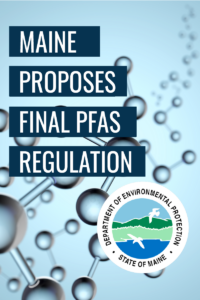PFAS
January 21, 2025 | Written by GreenSoft Technology, Inc.
Maine Proposes Final Text for PFAS Regulation
 PFAS notification requirements go into effect January 2026; PFAS ban goes into effect January 2032
PFAS notification requirements go into effect January 2026; PFAS ban goes into effect January 2032
On December 20, 2024, the DEP published the final proposed text of the state’s PFAS regulation.
Maine’s bill regulating the selling of per- and polyfluoroalkyl substances (PFAS), or “forever chemicals,” in the state of Maine was signed into law on April 16, 2024, and comes into effect in January 2026.
Per the final regulation, the initially indicated general reporting requirement for producers to notify the DEP about any product containing intentionally added PFAS sold in Maine is removed. Notification will only be required if the product is subject to prohibition and the DEP has determined that the use of PFAS in the product is a Currently Unavoidable Use (CUU).
With the elimination of the general reporting requirement, CUU proposals are now only applicable to products defined as prohibited for sale with PFAS present. The DEP will provide details on the program implementation and outline criteria required for CUU proposals applicable to upcoming Prohibited Categories.
For products listed under the 2026 Sales Prohibitions, it is anticipated the CUU exemptions will be released by the DEP in the Summer/Fall 2025-time frame. The other Sales Prohibitions (2029, 2032 & 2040) and their associated CUU exemptions will be released at later dates.
Currently unavoidable use (“CUU”), exemptions, and the effects on electronic equipment
The PFAS ban will take effect January 1, 2032 for most products (including electronic equipment) that contain intentionally added PFAS unless the DEP determines that the use of PFAS in the product is a currently unavoidable use. The DEP will accept proposals for currently unavoidable use (“CUU”) determinations. As the Prohibited Categories approach their prohibition date, the DEP will solicit requests for CUU designations.
The proposed regulation includes exemptions for federal preemption (including products meeting the standards or requirements of the FAA, NASA, DOD, or DHS), certain product packaging, used products or components, firefighting or fire-suppressing foams, certain medical prosthetics or orthotic devices and drugs regulated under the FDA, certain veterinary products regulated under the FDA, environmental or water testing devices, motor vehicles regulated under federal motor vehicle safety standards, watercrafts or seaplanes, semiconductors*, and non-consumer electronics and non-consumer laboratory equipment. These exemptions cover both the products, and equipment directly used in the manufacture of these products.
*The text of the semiconductor exemption states:
Chapter 90: 4.A (11): “A semiconductor, including semiconductors incorporated into electronic equipment, and equipment and materials used in the manufacture of semiconductors;
NOTE: While semiconductors incorporated into electronic equipment are exempted from this Chapter, electronic equipment in their entirety is not. Manufacturers of electronic equipment are still subject to sales prohibitions, currently unavoidable use determinations, and notification requirements on the balance of their product which is not comprised of semiconductors.”
The fact sheet and full text of the proposed rule can be found online here. GreenSoft maintains a PFAS Resource Center with up-to-date information about PFAS regulations around the globe here.
GreenSoft Technology offers a PFAS compliance solution for manufacturers
GreenSoft Technology’s PFAS Data Services solution provides affected companies with the chemical data from their supply chain that is needed to comply with the Maine PFAS regulation as well as other PFAS regulations around the globe.
Our data collection team will contact your suppliers to obtain data on the PFAS chemicals and other substances contained in your product and components. We’ll validate that data and check it for accuracy and completeness. With our Turnkey Service, we can generate the necessary compliance reports for you. Or you can use our GreenData Manager software to manage your company’s substance database and easily generate reports for this and other environmental regulations.
Contact us to learn more.





